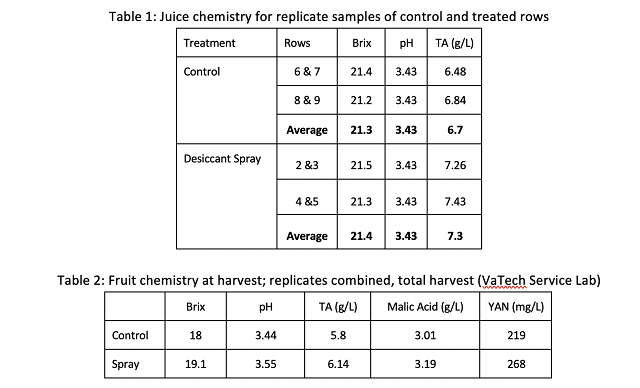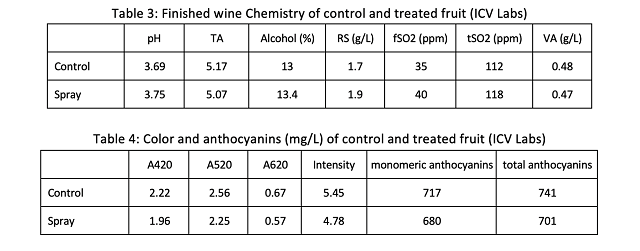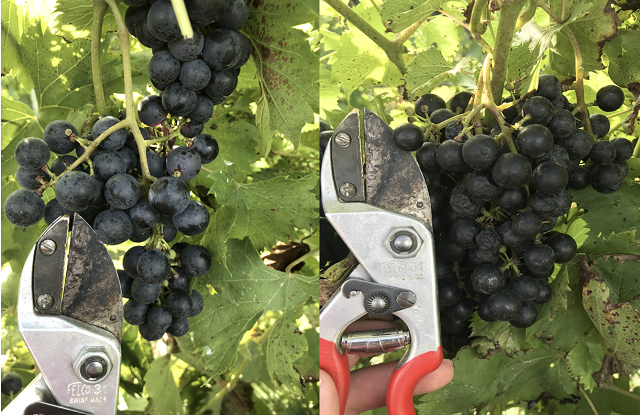Vineyard Desiccation Sprays to Improve Ripening in Chambourcin (2018)
Bill and Tremain Hatch
Zephaniah Farm and Vineyards
Summary
Originally developed to fight powdery mildew in grapevines, potassium bi-carbonate sprays also lead to desiccation of grapes. In Virginia’s humid and sometimes rainy climate, these sprays may help concentrate fruit that has been diluted. In this study, a 1.3 acre block of Chambourcin was split into four treatment blocks, two of which received a desiccation spray and two of which did not. Resulting fruit and wine chemistry were compared. Desiccation spray led to lower cluster weights but not lower berry weights. Replicated vineyard samples did not show differences in Brix at harvest but juice samples were one degree Brix different. In a blind triangle test, wine producers were not able to distinguish wines made from each treatment, nor were there differences in descriptors. The 2018 vintage was very wet. Results from this vintage are compared with results from the 2016 vintage, a drier year.
Introduction
The growing season in Virginia is usually hot and humid, including occasional rain events. These conditions generally prevent transpiration from the surface of the grape. Rain events can lead to berry swelling and dilution of sugar and flavor. One approach to combat the effects of these conditions, and hasten ripening in general, is the use of desiccation sprays in the vineyard.
Potassium bi-carbonate sprays were initially developed to fight powdery mildew grapevine leaves and in the fruit zone (1). Observations of sprayed fruit indicated the spray also caused desiccation (Mizuho Nita, personal communication, Feb 2019). Previous WRE studies of desiccation sprays in the vineyard have shown an increase in Brix at harvest with mixed results on acidity, wine phenolics, and sensory attributes. In a 2017 study of Cabernet Franc at Horton Vineyards, desiccation spray resulted in a decrease in cluster weight with an increase in Brix and pH in the sprayed fruit. The finished wine in this case had notably higher color intensity (an increase of 47% over control) as well as notable increases in polymeric anthocyanins and phenolics. In the same year, use of desiccation spray on Merlot at King Family vineyards again showed increase in Brix and decrease in berry weight at harvest. There was less of an effect, however, on phenolics or color in the finished wine. In these wines, there was a decrease in perceived herbaceous/green character in desiccant treated wines, and one of the three sprays used had higher perceived aromatic intensity and body. A previous study at Zephaniah in 2016 resulted in higher Brix at harvest with little change in acidity. In the finished wine, color intensity was lower in the treatment and there were no strong trends in the effects on phenolics. The wines were tasted by wine producers in blind triangle testing at two occasions. In the first, the wine was perceived as different in a triangle test, but not in the second. There were no strong trends in descriptors for these wines.
The growing season in 2018 was plagued with periodic rain and high humidity, providing an opportunity to examine the efficacy of desiccation spray in a wet year.
Procedures
One block of Chambourcin (1.3 acre Haverty Vineyard in Aldie, VA) was divided into two geographical replications of treated blocks and two geographical replications of untreated blocks. Treated blocks received applications of RG1950, a potassium carbonate based spray, on 8/22, 8/29, 9/7, and 9/12 from a backpack sprayer directed at the fruit zone. Both sides of the canopy were sprayed. Each spray event included 7.36 pounds per acre application focused on the fruit zone.
At harvest, one vine per row was fully harvested, clusters were counted, and cluster weights determined by vine. There were 4 vines sampled per treatment. In addition, samples were taken from replicate blocks for berry weight, brix, pH, and TA, resulting in two samples per treatment.
Fruit was harvested on 9/25, refrigerated overnight, then crushed and destemmed to fermentation vessels with the addition of SO2. Hungarian oak dust (2 gallons) and Hungarian oak chips (2 quarts) were added at the crusher. Fermentations were inoculated with 2lbs/1000 gallons BM45 rehydrated in 2.5lbs/1000 gallons Go Ferm, then co-inoculated with Beta Co-Inoc two days later (after a cap formed). Must was chaptalized at 44lbs/bin on 9/26. Caps were punched down twice per day until the cap fell. Wine was pressed on 10/3, allowed settle and complete fermentation, then transferred to barrel on 10/13 with addition of 70 ppm SO2.
Sensory analysis was completed by a panel of 27 wine producers. Wines were presented blind in randomly numbered glasses. Panelists were presented with three wines, two of one type and one of another, and identify which wine was different (a triangle test). They were then asked to score each wine on a scale of 0 to 10 for fruit intensity, structure and ripeness. Panelists were also given open ended questions to describe the wines.
Results
Average cluster weight was slightly higher for untreated clusters than for treated clusters (Figure 1), however treated samples did not have lower berry weight (Figure 2). In replicated vineyard samples prior to harvest, TA was higher in the desiccation spray treated grapes, however pH and brix were not different between treatments (Table 1). Juice chemistry from harvested bins, however, did show differences in brix, pH, TA, malic acid and YAN (Table 2) with the fruit that received the desiccation spray showing higher values of each.


Wine made from sprayed fruit had higher alcohol, consistent with higher starting Brix. Wine made from treated grapes also had slightly higher pH (Table 3). The control wine had higher color intensity, as well as higher levels of anthocyanins (Table 4), however both of these wines would be considered “lightly colored” with intensity level less than 6 (ETS labs).

There were no large differences in phenolics, though the control wine had slightly higher tannin than the wine from treated fruit (Table 5).

In a triangle test 11 out of 27 respondents were able to distinguish which wine was different, indicating the wines were not significantly different (Z=0.612, p=0.27). There were no significant differences in scores for fruit intensity, ripeness nor structure.
Comparison with 2016
This is the second year of this study. The 2016 growing season had much less rainfall than the 2018 season, which allows the opportunity to examine if the effects of the desiccation spray are consistent across vintages. Despite much lower harvest Brix in 2018 (18-19 Brix) compared to 2016 (22-23 Brix), the fruit treated with the desiccation spray had higher Brix at harvest in both years (0.9 degrees higher in 2016, 1.1 degrees higher in 2018). The desiccation treatment did not affect pH in 2016, however in 2018, treated fruit high a higher pH. Wines made from treated grapes had lower color intensity and anthocyanin concentration both years. Anthocyanins in general were 200-300 mg/L less in 2018 than 2017, but the decrease in treated wines appeared to be proportional each time. Tannins were 25% lower overall in 2018 than 2016, however in both years, treated wines had lower tannins. In sensory analysis, wines were not significantly different in either year.
Conclusions
- Desiccation spray consistently increases Brix at harvest by an average of 1 degree.
- In 2018, juice chemistry showed signs of general concentration including higher values for most grape components tested (TA, malic acid, sugar, pH).
- Changes in other measures of quality such as color and phenolics were minimal and not consistent across vintages.
- Differences in grape chemistry at harvest did not translate to significant differences in wine sensory qualities.
Figure 3: Effect of desiccation spray on grape appearance. Untreated clusters are on the left; treated clusters are on the right.

References
- Sawant, S.D. and Sawant, I.S. (2008). Use of potassium bi-carbonates for the control of powdery mildew in table grapes. Acta Hortic. 785, 285-292
